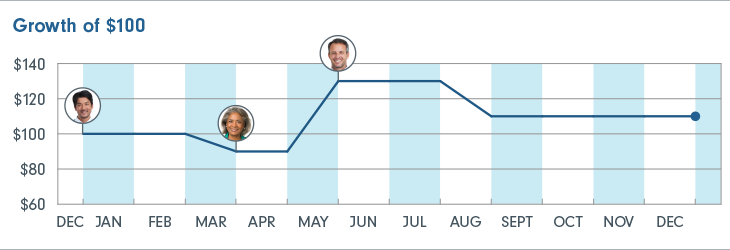Understanding your investment return

If you are new to investing or interested in learning more about the performance of your portfolio, understanding how your investment return is calculated is a great place to start.
Time-weighted return vs. dollar-weighted return
Returns can vary based on when you buy your investments. The two ways to calculate a rate of return are time-weighted return and dollar-weighted return.
Both methods are useful, but each evaluates a different type of performance. A time‑weighted rate of return, which helps in evaluating the performance of a fund or how a portfolio manager has performed, measures an investment’s return.
A dollar-weighted rate of return, which helps in evaluating the overall performance of an account after your personal account activities (such as contributions and withdrawals) have been factored in, measures your personal return.
As an investment fund manager, Fidelity uses the time-weighted methodology when reporting returns of the funds we manage.
Comparison: Time-weighted vs. dollar-weighted return
| Return type | What it measures |
Best for evaluating |
Answer the question(s) |
|---|---|---|---|
| Time-weighted (investment return) | Investment return for a specific period. | The performance of the specific investment or portfolio manager Comparing two different instruments |
How did the investment perform during a specific period? How did the portfolio manager perform? |
| Dollar-weighted (personal rate of return) | Account return, including 1. changes in the account value and 2. the impact of the amount and timing of contributions and withdrawals. |
Personal return factoring in the impact of contributions and withdrawals. | What was my personal return, factoring in the contributions/withdrawals that I made during a specific period? |
Let’s consider the following hypothetical example of three investors. Tom, Jill and Adam all purchased shares of a mutual fund (Fund A).
Fund A started the year at a price of $10 per unit. It then moved down and up before closing the year at $11 per unit. The Fund’s investment return for the year is 10%.

As shown in the table below, the time‑weighted return is identical for all three investors. However, the dollar‑weighted rate of return varies for each investor according to the size and timing of their contributions and withdrawals.
| Tom | Jill | Adam | |
|---|---|---|---|
| Starting investment | $100 | $50 | $20 |
| Additional purchases during the year |
$0 | $50 (March 31) |
$80 (May 31) |
| Total amount invested | $100 | $100 | $100 |
| Time-weighted (investment return) |
10% | 10% | 10% |
| Dollar-weighted (personal rate of return) |
10% | 19% | -15% |
| Ending account value (Investment return +/- cash flows) |
$110 | $116 | $90 |
Time-weighted return and dollar-weighted return are two different ways to measure the return experience of an investment. If you want to know what return your account earned when you factor in the timing and magnitude of cash flows, the dollar-weighted return method is the right one to use. If you want to evaluate the performance of your investment or investment manager, independent of your own activities, a time-weighted return is more appropriate.



